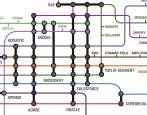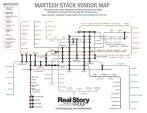The Challenge of Scale Part 5 - Marketing Automation
As Marketing Automation tools become more sophisticated, enterprises acquire the confidence to use them for increasingly larger and more frequent campaigns. Yet, we know from talking to customers that many Marketing Automation platforms will groan a bit at scale.
Real Story Group's Digital Marketing technology evaluation research suggests that most Marketing Automation platforms were designed for departmental use, rather than the needs of larger, diversified enterprises. It does mean you will have to carefully weigh alternatives and review trade-offs -- as well as set expectations -- as you grow and expand your campaign efforts.
So herewith is the next installment in our series on scalability, with this post offering a short list of some of the challenges you'll encounter, and how to address them.
Dealing With Segments
In a diversified enterprise, the first thing you want is the ability to separate list segments from campaigns. Lower-end systems often bind those two together in inconvenient ways. Higher-end systems tend to give you more flexibility and manageability on this, but don't always separate them neatly.
In building segments, you may also want to include "suppression" lists or rules, e.g., people who otherwise get included in a list segment, but should not receive the message for some reason. Many systems are weak here, forcing customers with more advanced needs to develop increasingly elaborate rules to compensate.
Templating Services
You will want to build and reuse specialized design templates for your messages, so the first thing to check is whether the vendor has a notion of templates at all -- or whether you need to manage and store those offline. Note that (as always) if you import raw markup or code into a WYSIWYG designer provided by your vendor, it may end up mangling your code or the appearance -- or both. Test this carefully.
Larger enterprises or those with sophisticated campaigns will want to exploit "nested" templates by composing reusable template elements (like "footer") into master templates. Only a handful of vendors does this well.
Global Settings
As you start managing multiple -- potentially overlapping -- campaigns, you'll want to apply some global rules and settings across them.
For example, some enterprises set rules around people not getting more than X messages per day or week. This is particularly important if the same individuals could be simultaneously receiving your newsletters, a custom one-off campaign, and qualify for dripped emails via a lead-nurturing process. Most systems cannot guarantee that a lead exists in only one campaign flow at a time, so you may need an overall governor at delivery time.
You also may want to set global rules about how data gets passed to your CRM system. Some vendors can align their notion of a campaign with Salesforce's very specific "Campaign" concept; others cannot.
Dynamic Content
Marketing Automation vendors differ markedly in their ability to support dynamic content. Nearly all of them can insert basic, fielded values into the body of a message, like the recipient's name -- that's not hard.
However, more complex logic requires the application of rules. For example, a rule may dictate displaying a different offer based on a customer's history, or displaying a different image based on geographic locale. Rules help you scale by enabling fewer templates and sending out variable messages under the same campaign.
The downside to this approach is that it can be difficult to tell what messages someone actually received, and this in turn can skew your analytics. And (like all personalization), you need to be careful about applying multiple rules, particularly since the behavior may not prove very easy to simulate in advance. Also, applying complex logic may also slow up the actual spooling of the messages, potentially delaying their issuance.
Be sure to test the usability of any rule builder. None of them are easy to use, but some are less difficult than others.
Campaign Reusability
You may want to create campaign templates, such as standard campaigns for webinar promotions that you can vary with each individual promo. Note that vendors differ in the extent to which logic and rules can be separated from campaigns, such that you can reuse them arbitrarily. This won't matter much if you have a single person generating the occasional campaign. If you have multiple people working on numerous, related campaigns, you won't want each campaign to become a process of starting from scratch.
The Importance of Good Information and Configuration Management
By now hopefully you've noticed a common theme: the need for strong information and configuration management.
Vendors have been a bit lax here, and you'll want to investigate carefully, since strong information and configuration management services are critical to success for larger digital marketing teams. Key considerations include:
- Repository Services, such as versioning and version control -- Maintaining previous versions of items and making sure that two people can't work on the same item at the same time (overwriting each other's work)
- Access Control -- Authorizing different users permissions (or not) for particular functions
- Search -- Finding a specific item from the large haystack of campaigns you've generated
- Workflow -- Putting campaigns and campaign elements through an approval process
- Date-based Publishing (and expiration) -- Setting up campaigns to run (and expire) in advance
- Component Reuse and Dependency Tracking -- Knowing what elements are being used in which campaigns
- Item Collections -- Grouping and categorizing collections of content, templates, rules, and campaigns
Again, many of these services may not matter to small marketing departments, but they will prove crucial to maintaining the sanity of large digital marketing teams.
What You Should Do
Technology development is all about trade-offs, so by definition, no Marketing Automation platform will prove ideal for everyone. For the larger enterprise, however, you'll want to carefully evaluate what life will be like with any given platform not so much on Day Three, but rather on Day 360. Some up-front research can prevent long-term problems.








